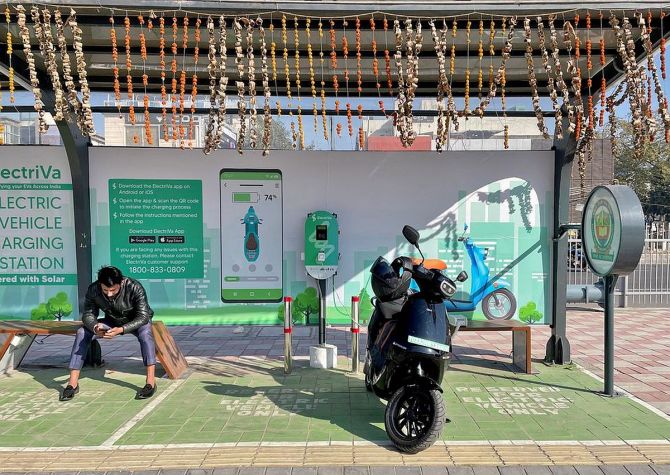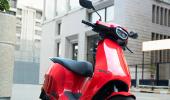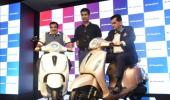Several manufacturers are under the scanner for alleged violations of the local sourcing rules under the Faster Adoption and Manufacturing of Electric Vehicles scheme; also consumer sentiment has taken a hit due to several incidents of EVs catching fire.
Shine Jacob & Sohini Das report.

With just a month left in this financial year, electric two-wheeler sales, so far, are at just 62 per cent of the ambitious target of 1 million units set for 2022-23 by the NITI Aayog.
According to VAHAN data, compiled by the Society of Manufacturers of Electric Vehicles (SMEV), 620,006 units of electric two-wheelers were sold across the country in FY23 until February 21.
Though the industry may miss the 1-million target, sales in FY23 are already up 146 per cent from 249,621 units sold in FY22.
Compared with FY21, there is a 13-fold jump.
Two-wheeler EV sales hit a few roadblocks during 2022-23: Several manufacturers are under the scanner for alleged violations of the local sourcing rules under the Faster Adoption and Manufacturing of Electric Vehicles (FAME) scheme; also consumer sentiment has taken a hit due to several incidents of EVs catching fire.
Besides, there were supply chain disruptions until September.
Still, the industry sounded optimistic about FY24.
Sohinder Gill, director general of SMEV and CEO of Hero Electric, said the issues related to the FAME II subsidy are expected to be sorted out.
"As far as demand goes, there has been no ebbing.
"But at this point, everyone needs to work together -- OEMs, policymakers, etc -- to achieve the target EV penetration in the country.
"We are very optimistic, and April onwards there will be stable growth," he said.
The sales target for 2023-24 is 2.3 million units of electric two-wheelers.
Sumit Chhazed, co-founder and chief executive officer of OTO, a digital commerce platform and two-wheeler financier, said: “We could have achieved the target for FY23, too, but supply chain issues in the first quarter led to a slowdown in demand until September.
"Besides, pending FAME II renewals of some of the EV brands and access to finance not getting opened up as expected were the major reasons for growth not performing as expected.”
Another reason for the less-than-expected showing is the rise in e-two-wheeler prices because of a halt on the FAME subsidy.
A majority of EV players have increased prices of their line-up in proportion to subsidies they received earlier, or by at least 20 per cent of the subsidy amount.
A senior executive of an e-two-wheeler firm told Business Standard that fire incidents too led to a perception impact on the industry.
Following the fire incidents, Ola Electric had to recall 1,441 S1 Pro scooters (in a specific batch), Okinawa Autotech took back 3,215 vehicles, Hyderabad-based PURE EV 2,000 vehicles, and Boom Motors its entire products.
“During that period, between April and August, we witnessed our EV sales go down by 20-30 per cent. The sentiment was really low,” Chhazed said.
Rajesh Saitya, co-founder & COO, GT Force, an e-two-wheeler maker, said April this year, the issues are likely to be ironed out.
“Makers are testing new batteries under the AIS 156 amendments as recommended by the Ministry of Road Transport and Highways (MoRTH) last year.
"These new batteries are great, and there would be no safety issues, and they would also be safe if they come in contact with water,” Saitya said.
Last year, the ministry said lithium-ion batteries of e-two-wheelers must meet all safety norms, including overcharging protection, an additional safety fuse, and charger and battery communication.
Saitya said firms are working on the AIS 156 amendment phase 2 certifications and these would be submitted to the Automotive Research Association of India (ARAI) by April by most players.
Some battery makers like Battrixx have received the ARAI certifications.
Gill, too, said that safety concerns are very valid.
“All players have already upgraded to AIS 156 Phase 1, and within the next one or two months, AIS 156 phase 2 certification would also be ready,” he said.
The industry expects that two-wheeler makers will be back on the growth path in FY24.
According to a report by JMK Research, overall electric two-wheeler sales declined from 79,844 units in October 2022 to 64,202 units in January 2023.
In November and December too, sales saw a quarter-on-quarter declining trend, dipping to 76,162 units and 64,348 units, respectively.
The top 10 players accounted for 91 per cent of total registrations witnessed in January 2023.
On a YoY basis, E2W sales in January 2023 surged by more than 130 per cent from that of January 2022.










